Aerospace Micro-Lesson #93
In This Section
Meteors and Meteorites
According to NASA, all those objects related to what we call “shooting stars” have different names depending on where they are located relative to Earth. Meteoroids are space rocks still outside the Earth’s atmosphere. Once they enter a planet’s atmosphere, we refer to them as meteors. If it doesn’t burn up completely during the trip through the atmosphere, then what is left earns the name of meteorite. Guest author Elizabeth Bero has put together some fascinating facts and research ideas about these objects just in time for the Leonids meteor shower November 17-18.
Next Generation Science Standards (NGSS):
- Discipline: Earth and Space Sciences
- Crosscutting Concept: Stability and Change
- Science & Engineering Practice: Constructing Explanations and Designing Solutions
GRADES K–2
2-ESS1-1. Use information from several sources to provide evidence that Earth events can occur quickly or slowly. (See also 2-PS1-4.)
Ask students: “Have you ever seen a streak of light going across the sky? Did someone tell you that was a falling star?” (Sing or play the song “Catch a Falling Star.”)
Catch a falling star and put it in your pocket
Never let it fade away
Catch a falling star and put it in your pocket
Save it for a rainy day
(Source: LyricFind Songwriters: Lee Julien Pockriss / Paul J. Vance Catch A Falling Star lyrics © Emily Music Corp)
A long time ago, people thought that stars were falling to Earth, because they did not understand yet that stars are really suns and are very far away from us. Even as recently as two hundred years ago people thought that meteors—those streaks of light—were rocks from volcanic eruptions somewhere on earth.
Every day, all over the world, tiny bits of rocks from space come through the atmosphere—the blanket of air surrounding our planet—and fall to earth. If you rub your hands together, you will feel your palms getting warm. This is friction. Energy like this can create heat, and heat can produce light. Rubbing against the atmosphere makes the tiny space rocks get warm and glow. This is the light that looks like a falling star. Most of the tiny rock bits are destroyed as they enter the atmosphere. Lucky for us we have an atmosphere! The atmosphere protects us from meteorites (rocks that fall all the way to the surface) as well as providing air to breathe and our weather. You need only look at the surface of the moon to learn what Earth might look like if we didn’t have an atmosphere. Watch this NASA video about the formation of the Moon’s craters.GRADES 3–5
4-ESS1-1. Identify evidence from patterns in rock formations and fossils in rock layers to support an explanation for changes in a landscape over time. (See also 3-PS2-4, 4-PS3-1, 4-PS3-3, and 4-ESS2-2)
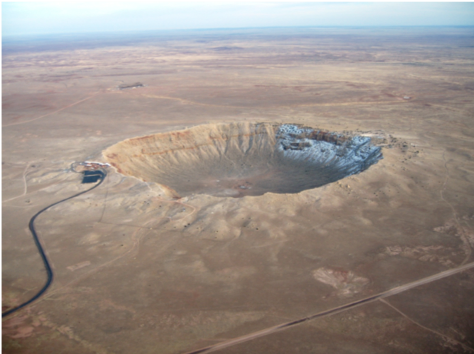 While most meteorites are so small that they vaporize as they enter the atmosphere, some are large enough to impact Earth’s surface, leaving an impact crater, like Meteor Crater in Arizona. Meteor Crater is also called Barringer’s Crater. A hundred years ago or so, a man named Barringer thought that this formation—thought to be volcanic by others—was an impact crater from a meteorite. He bought the land and hoped to get rich mining the iron from this crater. But he went broke, because he couldn’t find a ‘motherlode’ of iron anywhere. We now know that even though a large meteorite struck here and created a crater, it mostly disintegrated — the mass turning into energy and heat. There is no large mass of iron under the crater site.
While most meteorites are so small that they vaporize as they enter the atmosphere, some are large enough to impact Earth’s surface, leaving an impact crater, like Meteor Crater in Arizona. Meteor Crater is also called Barringer’s Crater. A hundred years ago or so, a man named Barringer thought that this formation—thought to be volcanic by others—was an impact crater from a meteorite. He bought the land and hoped to get rich mining the iron from this crater. But he went broke, because he couldn’t find a ‘motherlode’ of iron anywhere. We now know that even though a large meteorite struck here and created a crater, it mostly disintegrated — the mass turning into energy and heat. There is no large mass of iron under the crater site.
Remember, about 70% of the earth is covered with water, so 70% of the meteorites falling to earth fall into the oceans, where, if they are big enough, they can cause a tsunami! This would be a rare but devastating event. About the possible dangers to individuals: there is no record in history of any human killed by a meteorite, and just two (as of this writing) of someone being hit by a meteorite: back in the 1950s a woman in Alabama was hit by a football-sized meteorite that crashed through the roof of her rental home and struck her on the hip as she relaxed in her living room. More recently, a tiny piece of a larger meteorite that broke up as it entered the atmosphere
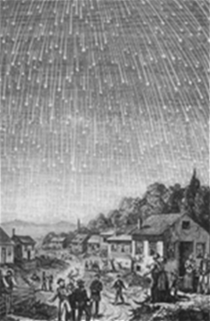 Meteors were originally thought to be an atmospheric phenomenon, hence the name meteor, which comes from the Greek for atmosphere (in case you wondered why the science of meteorology has nothing to do with meteors).
Meteors were originally thought to be an atmospheric phenomenon, hence the name meteor, which comes from the Greek for atmosphere (in case you wondered why the science of meteorology has nothing to do with meteors).
This is a wood cutting of the Great Meteor Shower of 1833. If you look up this event, you will find observations by a young Abraham Lincoln, as well as many others. More information is available here and here and here.
Meteorite craters are found around the world. Are any found near your home or in your state? Here is a map to help start your search.GRADES 6-8
MS-ESS2-2. Construct an explanation based on evidence for how geoscience processes have changed Earth’s surface at varying time and spatial scales. (See also MS-PS2-1, and MS-PS3-1.)
Fortunately for us, the larger a meteor is, the rarer it is. The smallest ones are the most common. Some meteors are dust from comets, and some meteor showers are associated with particular comets. Comets have a nucleus, a central semi-solid body, made up of gas, dust, and ice. As a comet comes close to the Sun, cometary material sublimates (converts directly from a solid to a gas). The gas (for example carbon dioxide and water vapor) and dust form a sort of atmosphere around the nucleus, called a “coma” (Latin for hair). The gas and dust are swept by the solar wind into a tail. (Note that the solar wind is not really a wind, but charged particles, mostly electrons and protons that continually stream away from the Sun.) The solar wind pushes the tail of the comet away in a direction that is away from the Sun. When the comet rounds the Sun and is moving away, the tail is still pushed away from the Sun, which is now behind the comet. This makes the tail stream out in “front” of the comet, in the direction of its motion. The comet is now travelling tail first! The dust and gas that make up the tail stay in the orbit of the comet. ‘Meteor showers’ happen because each year Earth moves through the Earth-crossing part of the comet's orbit. Over time, the debris in the orbit spreads out into patches, but scientists can predict into which patch Earth will move. Some comets have left lots of debris in their orbit, others not so much, and some comets' orbits have been “cleaned out” over time. So, some meteor showers produce lots of meteors and others very few. Although many meteors come from comets, others are bits of asteroids, others are bits of planets, or bits of the Moon.A meteor shower is named for direction in the sky and the nearby constellation from which the meteors appear to originate; this is called the ‘radiant.’ Two famous ones are the Leonids and Perseids. Listings of meteor showers with their dates and expected rates (how many meteors per hour) can be found here. Peak dates of the meteor showers are listed, but they can be seen for several days on each side of that peak date. The best time to see a meteor shower is on a moonless night after midnight, since after midnight, Earth is turning into the stream of meteoroids. Much like bugs hitting a windshield of a car, Earth ‘catches’ more meteorites on the leading edge of the orbital motion. Watching a meteor shower is easy—no special equipment needed! Just dress comfortably for the season (a bit warmly because you will be sitting still under an open sky), get a lawn chair or blanket to stretch out on and look up. It is not necessary to look at the radiant point, streaks of light can be seen across the sky. Moonless nights are best and of course, the less light pollution (artificial light near you) the more meteors you will see.
Each day, tons of space dust and debris fall through Earth's atmosphere. These “micrometeorites” are too small to create the shocks that would heat them to destruction, and so they may fall to the ground, where they can be collected. Look up ‘meteor showers’ on the internet for a complete listing of all known meteor showers and when they can be seen in any year.
Meteors are streaks of light across the sky. Think of meteorites as meteors that land “right on the ground” to help remember this label. Meteorites are sorted into three categories: stony (non-metallic and non-magnetic), irons (magnetic and metallic) and stony-irons (a mixture of the two). The majority of meteorites that fall to earth are stony, which look much like earth rocks. As a matter of fact, unless you observed a stony meteorite falling to earth, it would be difficult to identify it or even find it later. Only about 5% of all meteorites are metallic ‘irons’ but they comprise 95% of those meteorites found and studied or displayed in museums. For a tasty lesson in identifying different types of meteorites, try this one from JPL/NASA.
There is an inverse relationship between the size of a meteorite and the frequency of having one of that size fall to earth. Fortunately for all of us, large destructive ones are very rare. Even relatively small meteors can make noise and have a big impact as we have learned
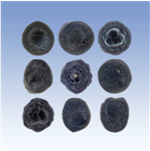 with recent meteors and meteorites captured on many dashboard and security cameras. In 2013, a meteor streaked across the dawn sky over Chelyabinsk, Russia. Meteors that make sound are called bolides. Making a sonic boom and leaving a trail in the sky, the Chelyabinsk meteoroid was a super-bolide. You may see it here.
with recent meteors and meteorites captured on many dashboard and security cameras. In 2013, a meteor streaked across the dawn sky over Chelyabinsk, Russia. Meteors that make sound are called bolides. Making a sonic boom and leaving a trail in the sky, the Chelyabinsk meteoroid was a super-bolide. You may see it here.
Micrometeorites can be found with a magnet on a string. This is a fun and interesting way to find your own bits of outer space. There are several websites that will help you identify your micrometeorites and make sure your magnetic bits are not roofing material or other debris. The best way to look for a micrometeorite is by dragging your magnet on a string at the base of a drain spout, but you can look anywhere. Micrometeorites will often be spherical and look metallic under a
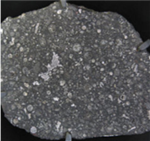 magnifying lens or microscope. Space.com has an article about identifying micrometeorites.
magnifying lens or microscope. Space.com has an article about identifying micrometeorites.
Meteorites are also categorized as ‘finds’ or ‘falls.’ The best way to identify a stony meteorite is to see it fall. One famous “fall” happened in Allende, Mexico in 1969. (This photo is from Wikipedia)
Irons, or metallic meteorites are more easily identified using magnets and can be found many years after falling; and would then be called a ‘find.’ This photo is of a meteorite from Canyon Diablo, another name for Meteor Crater. Today astronomers searching for meteorites like to look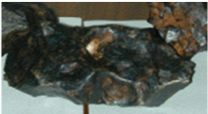 in Antarctica, where they search for the characteristic black stones on the white surface. The way
glaciers move helps shift those stones into areas where they can be more easily found. The Global Meteor Network, among others, installs small cameras aimed at the sky in order to triangulate the origin or direction that a meteorite came from, facilitating finding it and learning more about where its origin. Check out this site run by Alabama’s Marshall Space Flight Center.
in Antarctica, where they search for the characteristic black stones on the white surface. The way
glaciers move helps shift those stones into areas where they can be more easily found. The Global Meteor Network, among others, installs small cameras aimed at the sky in order to triangulate the origin or direction that a meteorite came from, facilitating finding it and learning more about where its origin. Check out this site run by Alabama’s Marshall Space Flight Center.GRADE 9-12
HS-ESS1-4. Use mathematical or computational representations to predict the motion of orbiting objects in the solar system. (See also HS-PS2-1 and HS-ESS1-6.)
High school students should be asking “why should we care?” about meteorite impacts.
Here is why:

This illustration is from the impact of Shoemaker-Levy 9 (ninth comet discovered by the team of Eugene and Carolyn Shoemaker, and David Levy) on Jupiter in July 1994. This comet was torn apart by Jupiter’s gravity as it passed by earlier and became a ‘string of pearls’ or small chunks of comet material, which scientists then calculated would impact Jupiter on its next trip around the sun. Each one of those chunks made a shockingly visible impact on Jupiter’s clouds as it hit. Around the world, people thought: “What if that happened HERE?” Discuss your reaction to this information. What should we do?
From that was born the Near Earth Network (NEN).
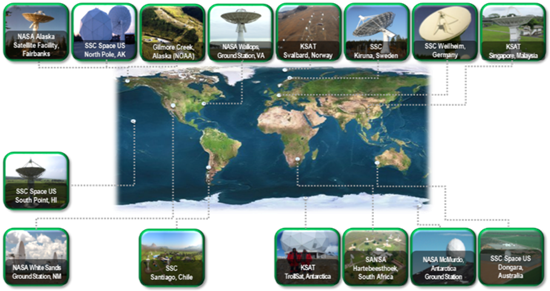 From the NEN website:
From the NEN website:
Formerly known as the Ground Network, the Near Earth Network (NEN) provides telemetry, commanding, ground-based tracking, data and communications services to a wide range of customers. The NEN provides these services to customers with satellites in low Earth orbit (LEO), geosynchronous orbit (GEO) highly elliptical orbit, Lunar orbit and missions with multiple frequency bands.
Customers are both national and international, government and commercial entities, NASA (Earth Science, Space Science, and Human Explorations missions) and non-NASA. The Near Earth Network utilizes both NASA-owned and commercial stations around the world to ensure proper service to customers. NASA Goddard Space Flight Center in Greenbelt, Maryland manages the operations of the Near Earth Network. You may find more information at https://www.nasa.gov/directorates/heo/scan/services/networks/nen.
Research topic suggestions from large meteorite impacts to small:Look up the Chicxulub crater. It is off the coast of the Yucatan peninsula in Mexico and is now thought to be the catastrophic event that brought an end to the age of dinosaurs 65 million years ago. (See this web page for a discussion of the K-T Event.)
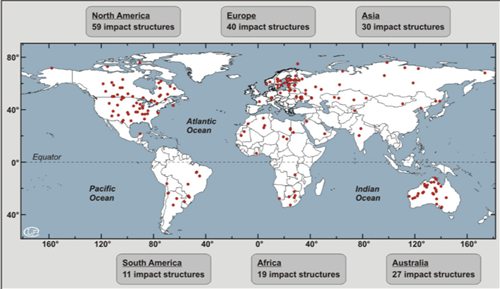 Some meteorite craters are visible on a map, some are not. Here’s a map of observed meteorite impacts on Earth. Because we have an atmosphere and weathering, many are eroded or even buried after a time and are now only visible from space or with special equipment.
Some meteorite craters are visible on a map, some are not. Here’s a map of observed meteorite impacts on Earth. Because we have an atmosphere and weathering, many are eroded or even buried after a time and are now only visible from space or with special equipment.
Meteor Crater is easily seen, because little erosion has taken place in its dry environment. Others are more eroded and harder to see from the ground, but are visible from space, such as this photo taken from the ISS of the Manicouagan crater in Canada, which is now a lake. Research how lidar and other new technologies are helping scientists find buried meteor craters.
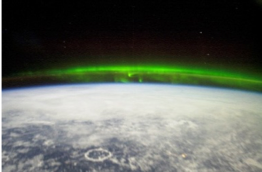 Research meteor showers and plan to try to view one. Observing a meteor shower is easy and requires no special equipment, but it helps to have a dark sky and be away from city lights.
Research meteor showers and plan to try to view one. Observing a meteor shower is easy and requires no special equipment, but it helps to have a dark sky and be away from city lights.
Another good research topic would be meteorite origins, such as those thought to be from Mars or the Moon—how do we know where they are from?
The destructive power of a potential meteor impact can be calculated. For an explanation of the math involved and comparisons of destructive force compared to nuclear forces, see this link.
Sten Odenwald writes Space Math problems. They are all intended to be one page, double-sided, with answers on the flip side. A few that relate specifically to meteors are listed here:
- Exploring Interplanetary Dust with the Parker Solar Probe
- Lunar Meteorite Impact Risks
- Solving Linear Equalities: Asteroids (p.43 in section 1.6.2)
- Probability of Compound Events
- Meteor Impacts - How Much Stuff?
https://stardate.org/nightsky/meteors
with thanks to Mitzi Adams and Dr. Caleb Fassett of NASA for editing help and the 9-12 grade worksheet
Worksheet: (from Dr. Caleb Fassett)
Ex. 8. Impact Hazards and Impact Craters
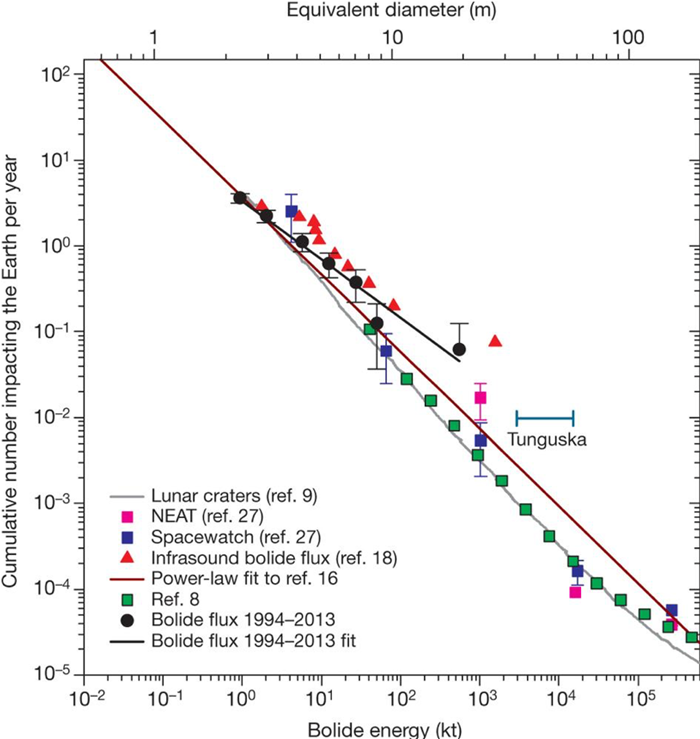
The diagram above (from Brown et el. 2013 in Nature) shows a variety of current data / estimates for the impact frequency of objects of various energies (bottom x-axis) and impactor sizes (top x-axis) on Earth. At these sizes, most of the objects that hit are asteroids or meteoroids derived from asteroids. The Earth and Moon have the same orbital distance around the Sun, this data is also relevant to the Moon’s impact frequency. For the Moon, however the frequencies on the y-axis need to be adjusted downward by a factor of 20 due to the fact that the Moon is smaller (i.e., has less surface area), and because of a slight gravitational focusing effect due to Earth’s much larger mass. Note the logarithmic scales: the powers of ten are marked while the smaller tick marks between the powers of ten are the integer values to be multiplied by the corresponding power of ten. Note also the term “Cumulative number” on the y-axis. This means, for example, that the second red triangle from the right means that the number of bolides hitting the Earth with an equivalent diameter (the diameter they would have if they had the same mass but were spherical) of ten meters or more is 2×10-2, or 0.2, meaning that one such bolide hits the Earth about once every five years on average.
1) Based on your examination of this graph:
(a) How many objects ≥2 m in diameter hit the Earth per year (note that diameter on the top x-axis)?
(b) From this, what is the impact flux of objects ≥2 m in diameter on the Moon?
2) A 2 m object has a very different effect when they hit the Moon than Earth.
(a) If such an object hits the Earth, what happens?
(b) If such an object hits the Moon, what happens?
3) The ~200 m diameter impactors (at the right edge of the graph) are more impressive. If such an impactor struck the continents, it would form a crater larger than Meteor Crater in Arizona (but a still be a couple of orders of magnitude smaller than the crater that killed the dinosaurs). Go to http://impact.ese.ic.ac.uk/ImpactEffects/ and evaluate the effect of a 200m impactor, with the following other suggested parameters:
- I suggest a distance of 10 km … although that may prove to be too close!
- Set the Projectile Density to 1500 kg/m3 [typical “rubble-pile” stony asteroid]
- Set the Impact Velocity to 17 km/s [typical Earth value]
- Choose an impact angle of 45˚ -- the most probable value.
- Choose a sedimentary target…
(a) How big a crater does this make?
(b) What is the recurrence interval (average period between) ~200 m bodies hitting Earth?
[Note in your response if you calculate it from the graph, or using the Earth Impact Effects program – they give slightly different answers…we actually do not know this answer with much confidence…]
1) Based on your examination of this graph:
(a) How many objects ≥2 m in diameter hit the Earth per year (note that diameter on the top x-axis)?
3-4. If claim >10 or < 1, lose points
(b) From this, what is the impact flux of ≥2 m in diameter on the Moon?
1/20 of the answer from part (a).
2) A 2 m object has a very different effect when they hit the Moon than Earth. (This is probably unsurprising given your answer to q1).
(a) If such an object hits the Earth, what happens?
Need to use the word “atmosphere” or burnup.
(b) If such an object hits the Moon, what happens?
Need to use the word “crater”
3) If a 200-meter-diameter impactor struck the continents, …
(a) How big a crater does this make?
2.4 km, 500 m depth (final values, after slumping)
(b) What is the recurrence interval (average period between) ~200 m bodies hitting Earth?
22000 yrs from program, 30000 yrs from graph, Aim for same order of magnitude
Sixty Years Ago in the Space Race:
November 12, 1959: Thor intermediate-range ballistic missile successful suborbital test, reaching an apogee of 320 miles.
